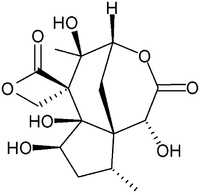Anisatin
Anisatin
 |
| Names |
| IUPAC name
(1'S,2'R,3S,4'R,5'R,7'R,8'R,11'R)-4',5',7',11'-tetrahydroxy-2',7'-dimethyl-9'-oxaspiro[oxetane-3,6'-tricyclo[6.3.1.0¹,⁵]dodecane]-2,10'-dione |
| Identifiers |
| |
5230-87-5  N N |
| 3D model (Jmol) |
Interactive image |
| 3DMet |
B05347 |
| ChEMBL |
ChEMBL517697  N N |
| ChemSpider |
103015  Y Y |
| ECHA InfoCard |
100.208.646 |
| KEGG |
C09294  N N |
| MeSH |
Anisatin |
| PubChem |
12306850 |
InChI=1S/C15H20O8/c1-6-3-7(16)15(21)13(6)4-8(23-10(18)9(13)17)12(2,20)14(15)5-22-11(14)19/h6-9,16-17,20-21H,3-5H2,1-2H3/t6-,7-,8-,9+,12+,13+,14+,15-/m1/s1  N NKey: GEVWHIDSUOMVRI-QWNPAUMXSA-N  Y Y
|
O=C1OC[C@]14[C@@]2(O)[C@H](O)C[C@H]([C@]23C[C@@H](OC(=O)[C@@H]3O)[C@@]4(O)C)C
|
| Properties |
| |
C15H20O8 |
| Molar mass |
328.32 g·mol−1 |
| log P |
-1.894 |
| Acidity (pKa) |
12.005 |
| Basicity (pKb) |
1.992 |
Except where otherwise noted, data are given for materials in their standard state (at 25 °C [77 °F], 100 kPa). |
 N verify (what is N verify (what is  Y Y N ?) N ?) |
| Infobox references |
|
|
Anisatin is an extremely toxic, insecticidally active component of the Shikimi plant.[1] It is used in folk remedies topically in Japan. Lethal dose = 1 mg/kg (i.p.) in mice. [2] Symptoms begin to appear about 1–6 hours after ingestion, beginning with gastrointestinal ailments, such as diarrhea, vomiting, and stomach pain, followed by nervous system excitation, seizures, loss of consciousness, and respiratory paralysis, which is the ultimate cause of death.[3]
References
- ↑ Lane, John F.; Koch, Walter T.; Leeds, Norma S.; Gorin, George (1952). "The toxin of Illicium anisatum. I. The isolation and characterization of a convulsant principle: anisatin". Journal of the American Chemical Society. 74 (13): 3211–2114. doi:10.1021/ja01133a002.
- ↑ Kouno, J Chem Soc Perkin Trans 1:1537 1988
- ↑ Naoru.com:シキミ(Japanese)
|
|---|
|
Receptor
(ligands) | | Agonists | |
|---|
| PAMs |
- (Abridged; see here for a full list): α-EMTBL
- Alcohols (e.g., ethanol)
- Anabolic steroids
- Avermectins (e.g., ivermectin)
- Barbiturates (e.g., phenobarbital)
- Benzodiazepines (e.g., diazepam)
- Bromide compounds (e.g., potassium bromide)
- Carbamates (e.g., meprobamate)
- Carbamazepine
- Chloralose
- Chlormezanone
- Clomethiazole
- Dihydroergolines (e.g., ergoloid (dihydroergotoxine))
- Etazepine
- Etifoxine
- Fenamates (e.g., mefenamic acid)
- Flavonoids (e.g., apigenin, hispidulin)
- Fluoxetine
- Flupirtine
- Imidazoles (e.g., etomidate)
- Kava constituents (e.g., kavain)
- Lanthanum
- Loreclezole
- Monastrol
- Neuroactive steroids (e.g., allopregnanolone, cholesterol)
- Niacin
- Nicotinamide (niacinamide)
- Nonbenzodiazepines (e.g., β-carbolines (e.g., abecarnil), cyclopyrrolones (e.g., zopiclone), imidazopyridines (e.g., zolpidem), pyrazolopyrimidines (e.g., zaleplon))
- Norfluoxetine
- Petrichloral
- Phenols (e.g., propofol)
- Phenytoin
- Piperidinediones (e.g., glutethimide)
- Propanidid
- Pyrazolopyridines (e.g., etazolate)
- Quinazolinones (e.g., methaqualone)
- Retigabine (ezogabine)
- ROD-188
- Skullcap constituents (e.g., baicalin)
- Stiripentol
- Sulfonylalkanes (e.g., sulfonmethane (sulfonal))
- Topiramate
- Valerian constituents (e.g., valerenic acid)
- Volatiles/gases (e.g., chloral hydrate, chloroform, diethyl ether, paraldehyde, sevoflurane)
|
|---|
| Antagonists | |
|---|
| NAMs |
- 1,3M1B
- 3M2B
- 17-Phenylandrostenol
- α5IA (LS-193,268)
- β-CCB
- β-CCE
- β-CCM
- β-CCP
- β-EMGBL
- Anabolic steroids
- Amiloride
- Anisatin
- β-Lactams (e.g., penicillins, cephalosporins, carbapenems)
- Basmisanil
- Bemegride
- Bilobalide
- CHEB
- Cicutoxin
- Cloflubicyne
- Cyclothiazide
- DHEA
- DHEA-S
- Dieldrin
- (+)-DMBB
- DMCM
- DMPC
- EBOB
- Etbicyphat
- FG-7142 (ZK-31906)
- Fiproles (e.g., fipronil)
- Flavonoids (e.g., amentoflavone, oroxylin A)
- Flumazenil
- Fluoroquinolones (e.g., ciprofloxacin)
- Flurothyl
- Furosemide
- Iomazenil (123I)
- Isoallopregnanolone
- Isopregnanolone (sepranolone)
- L-655,708
- Laudanosine
- Leptazol
- Lindane
- MaxiPost
- Morphine
- Morphine-3-glucuronide
- MRK-016
- Naloxone
- Naltrexone
- Nicardipine
- Non-steroidal antiandrogens (e.g., apalutamide, bicalutamide, enzalutamide, flutamide, nilutamide)
- Oenanthotoxin
- Pentetrazol (metrazol)
- Phenylsilatrane
- Picrotoxin (i.e., picrotin and picrotoxinin)
- Pregnenolone sulfate
- Propybicyphat
- PWZ-029
- Radequinil
- Ro 15-4513
- Ro 19-4603
- RO4882224
- RO4938581
- Sarmazenil
- SCS
- Suritozole
- TB-21007
- TBOB
- TBPS
- TCS-1105
- Terbequinil
- TETS
- Thujone
- U-93631
- Zinc
- ZK-93426
|
|---|
|
|---|
| | Agonists | |
|---|
| PAMs | |
|---|
| Antagonists | |
|---|
| NAMs | |
|---|
|
|---|
| | Agonists | |
|---|
| Antagonists | |
|---|
| NAMs | |
|---|
| PAMs | |
|---|
|
|---|
|
|---|
|
Transporter
(blockers) | |
|---|
|
Enzyme
(inhibitors) | |
|---|
|
| Others | Precursors | |
|---|
| Analogues | |
|---|
| Others | |
|---|
|
|---|
|
See also: GHBergics • Glutamatergics • Glycinergics |